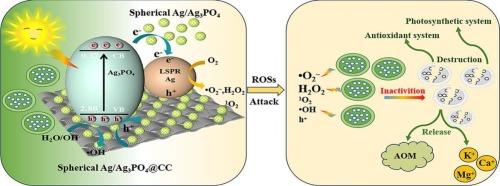Efficient algae inactivation by self-floating carbon-fiber cloth deposited with Ag/Ag3PO4 photocatalyst: Performance, mechanism and application insights
IF 4.7
3区 化学
Q2 CHEMISTRY, PHYSICAL
Journal of Photochemistry and Photobiology A-chemistry
Pub Date : 2025-09-21
DOI:10.1016/j.jphotochem.2025.116779
引用次数: 0
Abstract
Photocatalysis represents a promising technology for solving the environmental pollution problems of cyanobacterial bloom due to its simple operation, low energy consumption and high efficiency. However, photocatalysts usually confront with some drawbacks, including long-term treatment, low recyclability and secondary pollution. Herein, we report a self-floating photocatalyst of flexible carbon-fiber cloth (CC) deposited with Ag/Ag3PO4 with tunable morphologies(spheres, tetrahedrons, dodecahedrons, and cubes). Among the self-floating photocatalysts, the CC (3 cm × 3 cm) deposited with spherical Ag/Ag3PO4 (S-AP/CC) catalyst exhibited optimal efficiency of 99.99 % in inactivating Microcystis aeruginosa (OD680 = 0.6), while 92.32 % in degrading microcystin-LR under visible light irradiaiton. The excellent photocatalytic activity of S-AP/CC is mainly attributed to the synergistic effect of high surface activity of spherical Ag/Ag3PO4, surface plasmonic resonance effect of Ag nanoparticles and Schottky barrier of Ag/Ag3PO4 contact interface. Furthermore, the S-AP/CC photocatalyst also exhibited remarkable reusability and stability after eight cycling tests. The active species quenching experiments and ESR spectra confirmed that •O2− and H2O2 played significant roles in photocatalytic algal inactivation. This work opens up novel insight into the design and construction of effcient and recyclable self-floating photocatalysts for removing harmful algae contamination.

Ag/Ag3PO4光催化剂沉积自浮碳纤维布高效灭活藻类:性能、机理及应用见解
光催化具有操作简单、能耗低、效率高等优点,是解决蓝藻水华环境污染问题的一种很有前途的技术。但光催化剂存在处理时间长、可回收性低、二次污染等缺点。在此,我们报道了一种自浮式光催化剂,由柔性碳纤维布(CC)沉积Ag/Ag3PO4,具有可调的形貌(球体、四面体、十二面体和立方体)。在自浮式光催化剂中,由球形Ag/Ag3PO4 (S-AP/CC)沉积的CC (3 cm × 3 cm)在可见光照射下对铜绿微囊藻(OD680 = 0.6)的失活效率为99.99%,对微囊藻毒素- lr的降解效率为92.32%。S-AP/CC之所以具有优异的光催化活性,主要是由于球形Ag/Ag3PO4的高表面活性、Ag纳米粒子的表面等离子体共振效应和Ag/Ag3PO4接触界面的肖特基势垒的协同作用。此外,经过8次循环试验,S-AP/CC光催化剂也表现出了良好的可重复使用性和稳定性。活性物质猝灭实验和ESR光谱证实了•O2−和H2O2在光催化藻类灭活中起重要作用。这项工作为设计和建造高效、可回收的自漂浮光催化剂以去除有害藻类污染开辟了新的思路。
本文章由计算机程序翻译,如有差异,请以英文原文为准。
求助全文
约1分钟内获得全文
求助全文
来源期刊
CiteScore
7.90
自引率
7.00%
发文量
580
审稿时长
48 days
期刊介绍:
JPPA publishes the results of fundamental studies on all aspects of chemical phenomena induced by interactions between light and molecules/matter of all kinds.
All systems capable of being described at the molecular or integrated multimolecular level are appropriate for the journal. This includes all molecular chemical species as well as biomolecular, supramolecular, polymer and other macromolecular systems, as well as solid state photochemistry. In addition, the journal publishes studies of semiconductor and other photoactive organic and inorganic materials, photocatalysis (organic, inorganic, supramolecular and superconductor).
The scope includes condensed and gas phase photochemistry, as well as synchrotron radiation chemistry. A broad range of processes and techniques in photochemistry are covered such as light induced energy, electron and proton transfer; nonlinear photochemical behavior; mechanistic investigation of photochemical reactions and identification of the products of photochemical reactions; quantum yield determinations and measurements of rate constants for primary and secondary photochemical processes; steady-state and time-resolved emission, ultrafast spectroscopic methods, single molecule spectroscopy, time resolved X-ray diffraction, luminescence microscopy, and scattering spectroscopy applied to photochemistry. Papers in emerging and applied areas such as luminescent sensors, electroluminescence, solar energy conversion, atmospheric photochemistry, environmental remediation, and related photocatalytic chemistry are also welcome.

 求助内容:
求助内容: 应助结果提醒方式:
应助结果提醒方式:


